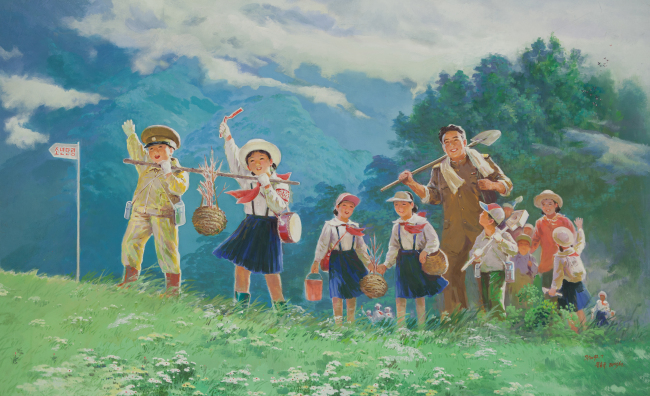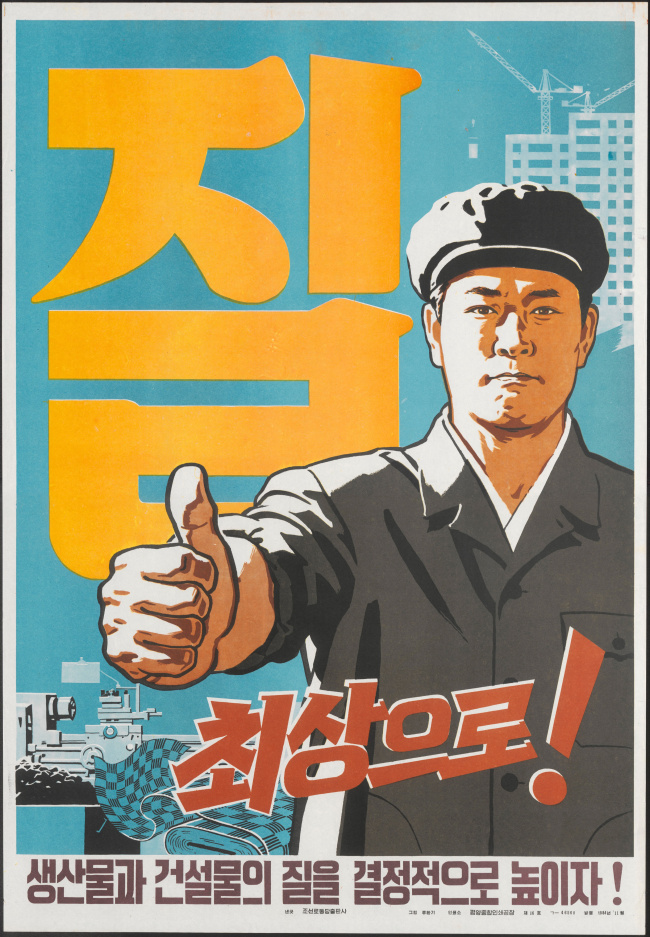Building the world’s edgiest art collection
Dutch collectors reveal rare collections of paintings, posters
By 이우영Published : July 22, 2015 - 18:10
Among the thousands of stamps that Dutch philatelist Wim van der Bijl has gathered from all over the world, the image on a small North Korean stamp left on him a strong impression.
The stamp collector soon found out that similar images in bigger sizes were on North Korean propaganda posters. He decided to buy more of them.
His colleague Ronald de Groen, who is also an avid stamp and painting collector, joined him in the building of a dangerous, yet thrilling collection of North Korean art.
From 1997 to 2011, de Groen built a large North Korean oil painting collection, featuring some 3,500 works of art created between 1960 and 2010, while van der Bijl collected some 1,000 North Korean propaganda posters made between 1953 and 2006.
The stamp collector soon found out that similar images in bigger sizes were on North Korean propaganda posters. He decided to buy more of them.
His colleague Ronald de Groen, who is also an avid stamp and painting collector, joined him in the building of a dangerous, yet thrilling collection of North Korean art.
From 1997 to 2011, de Groen built a large North Korean oil painting collection, featuring some 3,500 works of art created between 1960 and 2010, while van der Bijl collected some 1,000 North Korean propaganda posters made between 1953 and 2006.

Van der Bijl visited North Korea 24 times in 14 years to buy oil paintings and posters created by North Korean artists. There was no way to have direct contact with the artists, so they made purchases via local collectors.
The collection came to a sudden end in July 2011, when North Korean authorities detained van der Bijl for two weeks for unspecified reasons.
“I lost several kilos (in the prison),” said van der Bijl in an interview at the Seoul Museum of Art on Tuesday.
There was nothing unusual about his trip. It was to buy more recent paintings and posters, he said.
“They just knew I dealt with art and this and that. The reasons (for the detention) were not specifically mentioned.”
The rare collections of North Korean art are being showcased in Seoul for the first time at the Seoul Museum of Art. The exhibition titled the NK Project marks the 70th anniversary of the liberation of Korea from the Japanese colonial rule and the division of the country.
“The collection traveled for the first time,” said the 63-year-old collector.
Eighty posters from his collection are on display in the museum along with de Groen’s 70 North Korean oil paintings.

De Groen’s painting collection has been shown before in the Netherlands. Following the first exhibition in 2004 in Rotterdam in the Netherlands, the second exhibition is being held at Drents Museum in Assen until Aug. 30.
The 70 paintings are mostly portraits of North Korean people or depict scenes that portray North Koreans working tirelessly at a factory, on a field and in a science lab. De Groen said that these paintings were “mild” compared to other paintings in his collection.
“What has been shown here is very mild -- not really anti-American, anti-Japanese and anti-South Korean, because your secret service didn’t allow to show them here,” he said.
“What amazes us is that when South Korea is a democratic society, why are those paintings not allowed for people to see?”
The paintings currently on exhibit in the Netherlands feature more aggressive works that depict hostile sentiments against the U.S., South Korea and Japan. Those images feature the U.S. soldiers burning a field in North Korea or torturing a Korean man, a lazy-looking Japanese man smoking a cigarette with his feet washed by a young North Korean girl and a South Korean soldier caught, severely beaten and taken by North Korean soldiers.
The two collectors said they were attracted to the rarity of North Korean art and its artistic quality, and collecting them was no different from collecting Chinese or Russian paintings.
“One reason I collect them is because when North Korea collapses at one point and they no longer have the same system, most of the time, everything is destroyed because they don’t want the system anymore,” said de Groen.
“And they are artistically good, too.”
Posters are now valuable research materials that offer a rare glimpse into the North Korea‘s modern history as they show transitions made in the society under different slogans over time.
“You can understand what’s happening (in North Korea) just by reading the slogans in the poster,” said van der Bijl.
His poster collection is now being used as research material at Leiden University, which made photocopies of every poster and is conducting a study project to understand North Korean society from the 1950s to today.
De Groen expressed a wish to have his painting collection permanently shown in South Korea.
“In the end, it belongs here in South Korea. So I am looking for a museum or an investor who wants to buy the collection,” he said.
By Lee Woo-young (wylee@heraldcorp.com)









![[Hello India] Hyundai Motor vows to boost 'clean mobility' in India](http://res.heraldm.com/phpwas/restmb_idxmake.php?idx=644&simg=/content/image/2024/04/25/20240425050672_0.jpg&u=)








